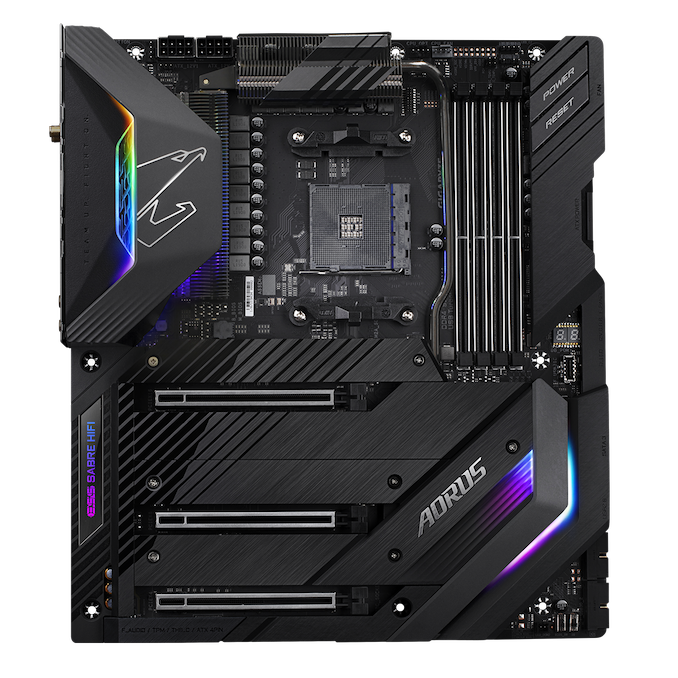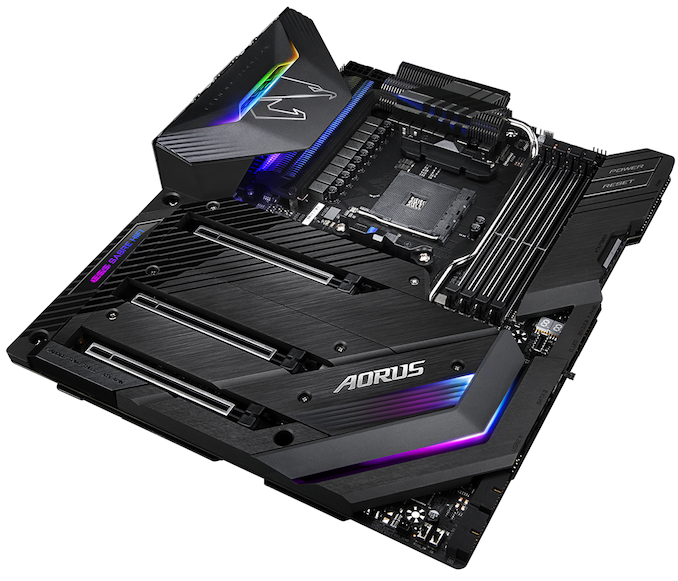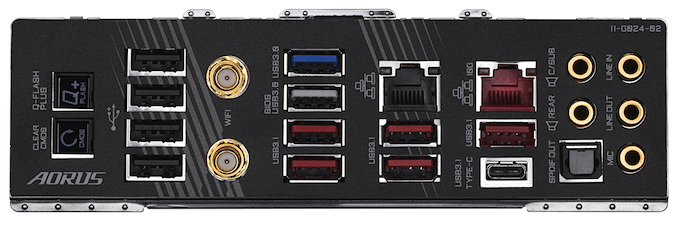The AMD X570 Motherboard Overview: Over 35+ Motherboards Analyzed
by Gavin Bonshor on July 9, 2019 8:00 AM ESTGIGABYTE X570 Aorus Xtreme
Moving onto GIGABYTE's launch day X570 product stack, and it seems to have upped the ante in a number of areas over the previous X470 generation of motherboards. Firstly, GIGABYTE has done a slightly different approach with its power delivery configurations; on paper, they look much higher spec than on previous AM4 models. One prime example of this is in the GIGABYTE X570 Aorus Xtreme which as it stands, is the brand's current flagship model, and is feature-packed with numerous premium componentry, as well as a beefy 16-phase power delivery for the CPU. The other unique feature for the X570 Aorus Xtreme is it's currently the only X570 model at launch to passively cool the warm running X570 chipset.
The X570 Aorus Xtreme is the current flagship from GIGABYTE with a large looking 16-phase power delivery for users looking to overclock the latest Ryzen 3000 series processors, as well as a solid high-end feature set. Across the majority of the PCB, we get Aorus themed armor with three PCIe 4.0 x4 M.2 slots each with its own heatsink which moulds into the PCB cover. There are also six SATA ports with support for RAID 0, 1 and 10 arrays. The CPU VCore section of the power delivery uses two 8-pin 12 V CPU power inputs to deliver power to the processor.
The chipset heatsink onboard the X570 Aorus Xtreme is also one of the only models so far that relies on passive cooling which is interesting as we know the X570 chipset will run with two variants, an 11 W and 15 W. On the rear panel cover is an Aorus Falcon design, with multiple areas with RGB LEDs that users can customize with the Aorus RGB Fusion software. In the top right-hand corner is a power and reset switch, with a small debug LED, and front panel USB 3.1 G2 Type-C port. There are three full-length PCIe 4.0 slots with no PCIe 4.0 x1 slots featured on this model. One of the aspects GIGABYTE is known for focusing on with its high-end models is the onboard audio solution. Adding to the implementation of a Realtek ALC1220 HD audio codec is an ESS Sabre 9218 DAC, with WIMA audio capacitors.
On the rear panel is a large number of inputs and outputs which includes five USB 3.1 G2 Type-A, one USB 3.1 G2 Type-C, two USB 3.1 G1 Type-A, and four USB 2.0 ports. There are two antenna connectors for the integrated Intel AX200 Wi-Fi 6 802.11ax wireless interface, as well as two Ethernet ports which are powered by an Aquantia AQC107 10 G, and Intel I211-AT Gigabit NIC pairing. The Realtek ALC1220-VB HD audio codec adds five 3.5 mm audio jacks and an S/PDIF optical output. Also featured is a clear CMOS switch and Q-Flash Plus BIOS flashing button.
The GIGABYTE X570 Aorus Xtreme is a fine example of what vendors can do for its flagship models on the X570 chipset with plenty of USB 3.1 G2 ports on the rear panel. Dual networking with a 10 G NIC, Wi-Fi 6 capability, and 16-phase power delivery for the CPU make the X570 Aorus Xtreme very attractive. This model has an MSRP of $699 which represents the top end of the X570 product stack at launch, but with everything on offer, it was always expected to be expensive.













225 Comments
View All Comments
PeachNCream - Tuesday, July 9, 2019 - link
Pretty much this. Modern games on DX12 won't see any benefit unless the game developer bakes in support (which they appear uninterested in doing for cost reasons) and older games run very well on a single modern GPU. AMD and NV are hardly acknowledging SLI these days either and nowhere but at the top end so there is even less compulsion for developers to bother with supporting it. All in all, you're better off not worrying about SLI unless the industry changes direction significantly in the next few years.ajlueke - Tuesday, July 9, 2019 - link
The real question however, is does all this power delivery actually have any practical benefits? If I drop a 3000 series CPU in an X570 board vs X470, can I achieve any additional performance? And what is the power consumption differences in the respective chipsets? That is the type of info I would like to see.PeachNCream - Tuesday, July 9, 2019 - link
It's a marketng differentiator only as motherboard manufacturers all use the same core components and are quick to emulate one another with similar features. Through branding and obscure features that do not significantly impact computer operation, they search for something they can offer that may encourage you to make a purchase in a very, very crowded field of offerings.lopri - Tuesday, July 9, 2019 - link
Solid power delivery for high-performance CPUs is perhaps the farthest thing from obscure marketing features. OEMs do play with marketing BS for differentiation, but the underlying power delivery system is extremely important and can impact everyday operation for these multi-core CPUs.PeachNCream - Wednesday, July 10, 2019 - link
At long as it meets AMD specifications, no it won't. If it doesn't meet specifications, then it's a bad design. There's no reason to tout being mediocre or a hair or two above mediocre unless you're running out of unique bullet points for the backside of the box that nobody bothers to read anyway.Death666Angel - Tuesday, July 9, 2019 - link
Stock performance will be the same across the board unless the manufacturer royally screwed up and the power delivery has to throttle due to temperatures (which there are some cases of with super cheap motherboards and 8 cores). Doing OC (and PBO is already OC) is where things start to change. More / better phases means less heat output and better voltages (ripple). This can potentially give you better clocks. But most of this is only useful when you start OCing on water or sub zero systems. Air cooled overclocking will hardly benefit at all. And regarding power consumption you can go into a lot of detail. Sometimes more power phases simply destroys efficiency, when they are all fired up all the time. Sometimes more power phases are smartly managed and load balanced to be kept at their optimal efficiency. It really depends on the implementation.Peter2k - Wednesday, July 10, 2019 - link
If you leave everything at stock, then there is no real reason to upgradeMost people would think keeping the socket backwards compatible as an upside
In a desktop the only real reason why we think about power draw going up from 5w to 11w is because manufactures like to keep the cooling block small, and those need a fan
Chipset fans bring back memories out of terrible noisy days
Also I remember chipset coolers to be a bit bigger in the past, I'm sure if you're just trying to provide food cooling, without trying to hit that gamer look, then you can cool that chipset without active fan
If you want to try your hand at OC'ing you should probably want the better power delivery
And there is no telling if the older boards will also run fine with higher memory speeds
Guessing they would, at least until the magical 3600, that's not that outlandish high
And how much that affects performance this time around still has to be tested
Short story
You have a Ryzen already, just make it a drop in replacement
No need to throw out the board
Peter2k - Wednesday, July 10, 2019 - link
Any one that would argue about the electricity costs going up (I've encountered those) should also not that all that shiny bling probably draws more watts then the 6w or so difference between last gen and this genpavag - Tuesday, July 9, 2019 - link
I expected benchmarks.sorten - Tuesday, July 9, 2019 - link
You expected benchmarks on 35+ boards that were released two days ago, and many of which aren't even available at retail?